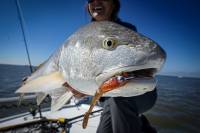Florida Charges 10 People With Felony Use of Gillnet in Fish Poaching
In 1995, Florida banned all uses of monofilament and multifilament gillnet due to its substantial toxicity to marine life and diving birds. But gillnet poaching persists.
On Thursday, Jan. 6, officials in St. Petersburg, Fla., tracked, arrested, and charged 10 out-of-state poachers for their illegal use of monofilament gillnets. The suspects had used the outlawed nets to capture and kill over 500 pounds of fish, sharks, and shellfish near the Skyway Bridge North Rest Area.
In a press release, the Florida Fish and Wildlife Conservation Commission (FWC) revealed that the suspects were in possession of more than 1,600 feet of monofilament entanglement net, also known as “gillnet” — enough to cover four-and-a-half football fields.
The 10 male suspects face third-degree felony penalties of up to 5 years behind bars and/or a $5,000 fine. Each man is also charged with first- and second-degree misdemeanors. The first-degree charges carry maximum penalties of up to a year of jail time and/or a $1,000 fine. Each second-degree offense comes with up to 60 days of jail time and/or a $500 fine.
Thursday’s arrest followed a brief period of surveillance after authorities received an anonymous tip.
Gillnet: A Marine Disaster Commonly Used in Fish Poaching

Gillnet is made up of a vast network of highly tensile micro-threads. Once submerged in water, the threads become virtually undetectable. The net then captures fish, shellfish, and mammalian life without discretion.
It’s a guaranteed death sentence by design — the micro-threads ensnare and cut into the gills and teguments of the animal caught in it. Poachers have used gillnet as an indiscriminate weapon to kill a wide range of marine life.
Gillnet’s invisibility also means that an abandoned net is difficult to detect and retrieve. Active and abandoned gill net has contributed to the endangerment of various marine life. Threatened sea turtles, diving birds, and a litany of mammals like manatees, dolphins, porpoises, sea lions, seals, and whales all fall prey to it.
In another, more passive environmental detriment, gillnet pollutes marine environments by capturing and holding on to detritus and garbage.
Despite its ban in Florida nearly 30 years ago, efforts to rein in its use continue. Gillnet recovery is among the least successful marine remediation efforts to date.
Marine Resources & Tipline
As part of its ongoing marine cleanup efforts, the FWC has established the Monofilament Recovery and Recycling Program. The statewide effort encourages gillnet recycling through a network of drop spots and promotes volunteer cleanup events.
The FWC encourages citizens and visitors to report any activity that might endanger land or marine life by calling the Wildlife Alert Hotline at 888-404-3922.
The post Florida Charges 10 People With Felony Use of Gillnet in Fish Poaching appeared first on GearJunkie.

